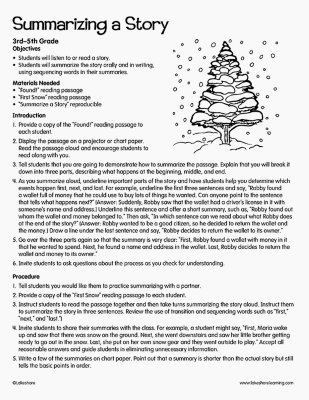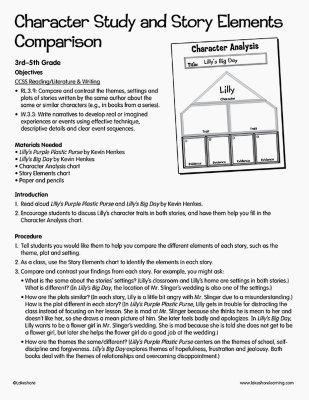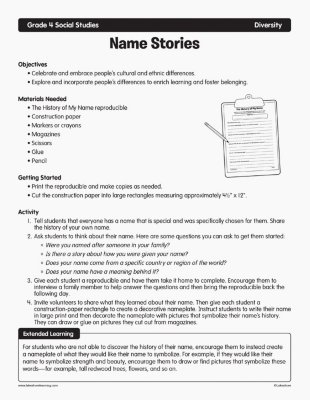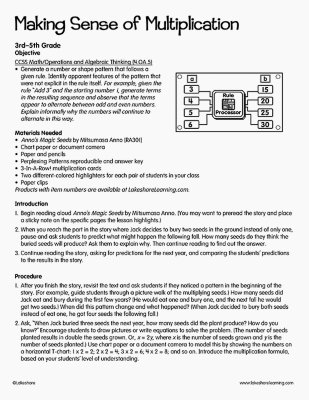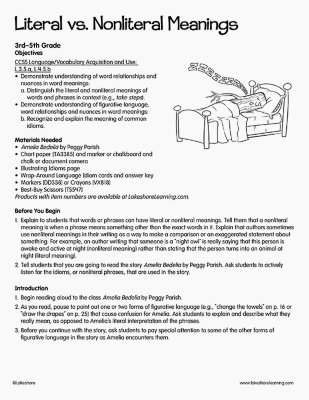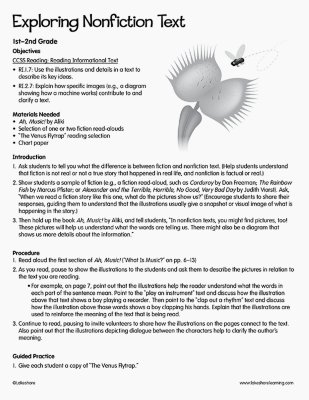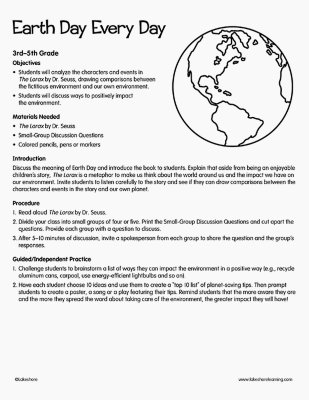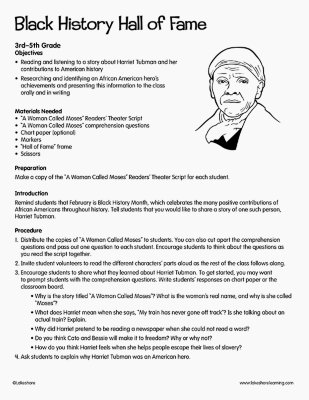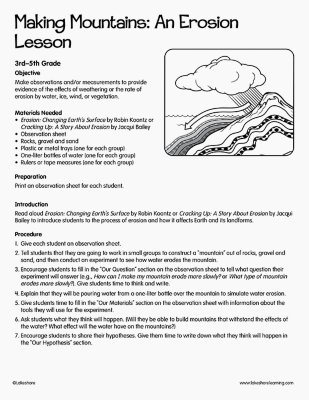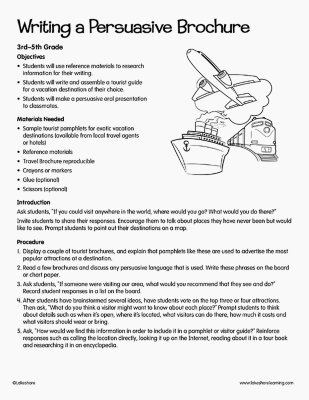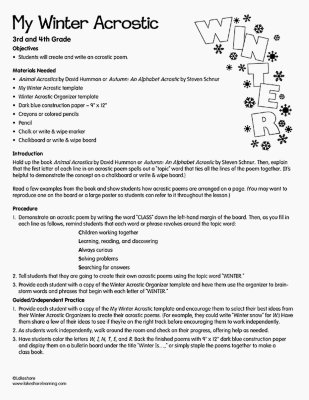Narrow by Grade
- Infant (0)
- Toddler (1)
- Preschool (0)
- Pre-K (11)
- Kindergarten (13)
- 1st (21)
- 2nd (14)
- 3rd (15)
- 4th (14)
- 5th (6)
- 6th & Up (0)
Grade 4th
Narrow by Age
- 0-18m (0)
- 18-36m (0)
- 3 yrs. (0)
- 4 yrs. (0)
- 5 yrs. (0)
- 6 yrs. (0)
- 7 yrs. (0)
- 8 yrs. (9)
- 9 yrs. (14)
- 10 yrs. (5)
- 11 yrs. & Up (0)
Age
14 results for "story"
Filters
Clear All
Summarizing a Story
4th Grade
Objectives Students will listen to or read a story. Students will summarize the story in writing, using sequencing words in their summaries. Materials Needed “Found!” reading passage “First Snow” reading passage “Summarize a Story” reproducible Introduction Provide a copy of the “Found!” reading passage to each student. Display the passage on a projector or chart paper. Read the passage aloud and encourage students to read along with you. Tell students that you are going to demonstrate how to summarize the passage. Explain that you will break it down into three parts, describing what happens at the beginning, middle, and end. As you summarize aloud, underline important parts of the story and have students help you determine which events happen first, next, and last. For example, underline the first three sentences and say, “Robby found a wallet full of money that he could use to buy lots of things he wanted. Can anyone point to the sentence that tells what happens next?” (Answer: Suddenly, Robby saw that the wallet had a driver’s license in it with someone’s name and address.) Underline this sentence and offer a short summary, such as, “Robby found out whom the wallet and money belonged to.” Then ask, “In which sentence can we read about what Robby does at the end of the story?” (Answer: Robby wanted to be a good citizen, so he decided to return the wallet and the money.) Draw a line under the last sentence and say, “Robby decides to return the wallet to its owner.” Go over the three parts again so that the summary is very clear: “First, Robby found a wallet with money in it that he wanted to spend. Next, he found a name and address in the wallet. Last, Robby decides to return the wallet and money to its owner.” Invite students to ask questions about the process as you check for understanding.
View Lesson PlanCharacter Study and Story Elements Comparison
3rd Grade - 4th Grade
Objectives CCSS Reading/Literature & Writing RL.3.9: Compare and contrast the themes, settings and plots of stories written by the same author about the same or similar characters (e.g., in books from a series). W.3.3: Write narratives to develop real or imagined experiences or events using effective technique, descriptive details and clear event sequences. Materials Needed Lilly’s Purple Plastic Purse by Kevin Henkes Lilly’s Big Day by Kevin Henkes Character Analysis chart Story Elements chart Paper and pencils Introduction Read aloud Lilly’s Purple Plastic Purse and Lilly’s Big Day by Kevin Henkes. Encourage students to discuss Lilly’s character traits in both stories, and have them help you fill in the Character Analysis chart.
View Lesson PlanMy Awesome, Amazing, Very Good, Super-Great Day Story
3rd Grade - 4th Grade
Objectives Students will listen to, recall and interpret information from literature. Students will make connections to their personal experiences. Students will write a descriptive paragraph. Materials Needed Alexander and the Terrible, Horrible, No Good, Very Bad Day by Judith Viorst Graphic organizer Revising and Editing checklist Introduction Read aloud Alexander and the Terrible, Horrible, No Good, Very Bad Day to your class. After you read, ask students to recall the things that happened to Alexander that added to his terrible, horrible, no good, very bad day. Then ask students to think about what could have happened differently to turn Alexander’s day into an awesome, amazing, very good, super-great day. Invite volunteers to share their responses.
View Lesson PlanName Stories
4th Grade
Objectives
- Celebrate and embrace people’s cultural and ethnic differences.
- Explore and incorporate people’s differences to enrich learning and foster belonging.
Making Sense of Multiplication
3rd Grade - 4th Grade
Objective Generating a number or shape pattern that follows a given rule Identifying arithmetic patterns and explaining them using properties of operations Materials Needed Anno’s Magic Seeds by Mitsumasa Anno Chart paper or document camera Paper and pencils Perplexing Patterns reproducible and answer key 3-In-A-Row! multiplication cards Two different-colored highlighters for each pair of students in your class Paper clips Introduction Begin reading aloud Anno’s Magic Seeds by Mitsumasa Anno. (You may want to preread the story and place a sticky note on the specific pages the lesson highlights.) When you reach the part in the story where Jack decides to bury two seeds in the ground instead of only one, pause and ask students to predict what might happen the following fall. How many seeds do they think the buried seeds will produce? Ask them to explain why. Then continue reading to find out the answer. Continue reading the story, asking for predictions for the next year and then comparing the students’ predictions to the results in the story.
View Lesson PlanLiteral vs. Nonliteral Meanings
3rd Grade - 4th Grade
Objective CCSS Language/Vocabulary Acquisition and Use: L.3.5.a, L.4.5.b Demonstrate understanding of word relationships and nuances in word meanings: a. Distinguish the literal and nonliteral meanings of words and phrases in context (e.g., take steps). Demonstrate understanding of figurative language, word relationships and nuances in word meanings: b. Recognize and explain the meaning of common idioms. Materials Needed Amelia Bedelia by Peggy Parish Chart paper and marker or chalkboard and chalk or document camera Illustrating Idioms page Wrap-Around Language Idiom cards and answer key Markers or Crayons Best-Buy Scissors Before You Begin Explain to students that words or phrases can have literal or nonliteral meanings. Tell them that a nonliteral meaning is when a phrase means something other than the exact words in it. Explain that authors sometimes use nonliteral meanings in their writing as a way to make a comparison or an exaggerated statement about something. For example, an author writing that someone is a “night owl” is really saying that this person is awake and active at night (nonliteral meaning) rather than stating that the person turns into an animal at night (literal meaning). Tell students that you are going to read the story Amelia Bedelia by Peggy Parish. Ask students to actively listen for the idioms, or nonliteral phrases, that are used in the story. Introduction Begin reading aloud to the class Amelia Bedelia by Peggy Parish. As you read, pause to point out one or two forms of figurative language (e.g., “change the towels” on p. 16 or “draw the drapes” on p. 25) that cause confusion for Amelia. Ask students to explain and describe what they really mean, as opposed to Amelia’s literal interpretation of the phrases. Before you continue with the story, ask students to pay special attention to some of the other forms of figurative language in the story as Amelia encounters them.
View Lesson PlanExploring Nonfiction Text
4th Grade
Objectives CCSS Reading: Reading Informational Text RI.1.7: Use the illustrations and details in a text to describe its key ideas. RI.2.7: Explain how specific images (e.g., a diagram showing how a machine works) contribute to and clarify a text. Materials Needed Ah, Music! by Aliki Selection of one or two fiction read-alouds “The Venus Flytrap” reading selection Chart paper Introduction Ask students to tell you what the difference is between fiction and nonfiction text. (Help students understand that fiction is not real or not a true story that happened in real life, and nonfiction is factual or real.) Show students a sample of fiction (e.g., a fiction read-aloud, such as Corduroy by Don Freeman; The Rainbow Fish by Marcus Pfister; or Alexander and the Terrible, Horrible, No Good, Very Bad Day by Judith Viorst). Ask, “When we read a fiction story like this one, what do the pictures show us?” (Encourage students to share their responses, guiding them to understand that the illustrations usually give a snapshot or visual image of what is happening in the story.) Then hold up the book Ah, Music! by Aliki, and tell students, “In nonfiction texts, you might find pictures, too! These pictures will help us understand what the words are telling us. There might also be a diagram that shows us more details about the information.”
View Lesson PlanEarth Day Every Day
3rd Grade - 5th Grade
Objectives Students will analyze the characters and events in The Lorax by Dr. Seuss, drawing comparisons between the fictitious environment and our own environment. Students will discuss ways to positively impact the environment. Materials Needed The Lorax by Dr. Seuss Small-Group Discussion Questions Colored pencils, pens or markers Introduction Discuss the meaning of Earth Day, and introduce the book to students. Explain that aside from being an enjoyable children’s story, The Lorax is a metaphor to make us think about the world around us and the impact we have on our environment. Invite students to listen carefully to the story and see if they can draw comparisons between the characters and events in the story and our own planet.
View Lesson PlanCharacter Building: Bullying
3rd Grade - 5th Grade
Objectives Students will listen and respond to literature read aloud by the teacher. Students will share interpretations of lessons in a story and learn to apply these lessons to their own lives. Materials Needed A Bad Case of Stripes by David Shannon Chalkboard, sentence strips or interactive whiteboard Notebook paper Introduction Ask students if they have a favorite food that might surprise others, like broccoli, spinach or beets! Invite volunteers to tell the class what this surprising food is. Tell students that you are going to read a story in which the main character has an odd choice for a favorite food. Ask students to pay special attention to what happens to this character, how her classmates react to her, and what she does to solve her problem. Read aloud A Bad Case of Stripes by David Shannon.
View Lesson PlanBlack History Hall of Fame
3rd Grade - 5th Grade
Objectives Reading and listening to a story about Harriet Tubman and her contributions to American history Researching and identifying an African American hero’s achievements and presenting this information to the class orally and in writing Materials Needed “A Woman Called Moses” Readers’ Theater Script “A Woman Called Moses” comprehension questions Chart paper (optional) Markers “Hall of Fame” frame Scissors Preparation Make a copy of the “A Woman Called Moses” Readers’ Theater Script for each student. Introduction Remind students that February is Black History Month, which celebrates the many positive contributions of African Americans throughout history. Tell students that you would like to share a story of one such person, Harriet Tubman.
View Lesson PlanMaking Mountains: An Erosion Lesson
4th Grade
Objective Make observations and/or measurements to provide evidence of the effects of weathering or the rate of erosion by water, ice, wind, or vegetation. Materials Needed Erosion: Changing Earth’s Surface by Robin Koontz or Cracking Up: A Story About Erosion by Jacqui Bailey Observation sheet Rocks, gravel and sand Plastic or metal trays (one for each group) One-liter bottles of water (one for each group) Rulers or tape measures (one for each group) Introduction Read aloud Erosion: Changing Earth’s Surface by Robin Koontz or Cracking Up: A Story About Erosion by Jacqui Bailey to introduce students to the process of erosion and how it affects Earth and its landforms.
View Lesson PlanWriting a Persuasive Brochure
3rd Grade - 5th Grade
Objectives Using reference materials to research for their writing Introducing the topic or text they are writing about, stating an opinion and creating an organizational structure that lists reasons Providing reasons that support the opinion Reporting on a topic or text, telling a story, or recounting an experience in an organized manner, using appropriate facts and relevant, descriptive details to support main ideas or themes; speaking clearly at an understandable pace Materials Needed Sample tourist pamphlets for exotic vacation destinations (available from local travel agents or hotels) Reference materials Travel Brochure reproducible Crayons or markers Glue (optional) Scissors (optional) Introduction Ask students, “If you could visit anywhere in the world, where would you go? What would you do there?” Invite students to share their responses. Encourage them to talk about places they have never been but would like to see. Prompt students to point out their destinations on a map.
View Lesson PlanFamily Interview
4th Grade
Objectives
- Develop an understanding of and appreciation for different cultures.
- Report on a topic or text, tell a story, or recount an experience in an organized manner.
My Winter Acrostic
3rd Grade - 5th Grade
Objectives Reading: Literature Reading and comprehending grade-appropriate literature, including stories, dramas, and poetry Writing Writing an acrostic poem Materials Needed Animal Acrostics by David Hummon or Autumn: An Alphabet Acrostic by Steven Schnur My Winter Acrostic template Winter Acrostic Organizer template Dark-blue construction paper - 9" x 12" Crayons or colored pencils Pencil Chalk or write & wipe marker Chalkboard or write & wipe board Introduction Hold up the book Animal Acrostics by David Hummon or Autumn: An Alphabet Acrostic by Steven Schnur. Then explain that the first letter of each line in an acrostic poem spells out a “topic” word that ties all the lines of the poem together. (It’s helpful to demonstrate the concept on a chalkboard or write & wipe board.) Read a few examples from the book and show students how acrostic poems are arranged on a page. (You may want to reproduce one on the board or a large poster so students can refer to it throughout the lesson.)
View Lesson Plan